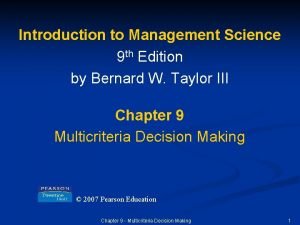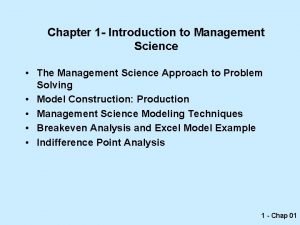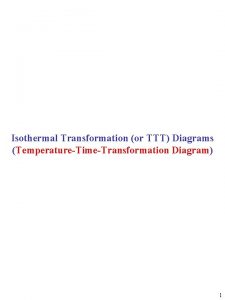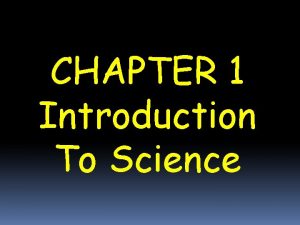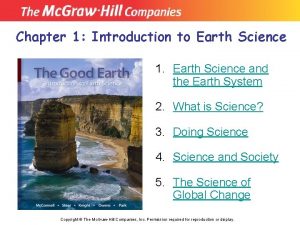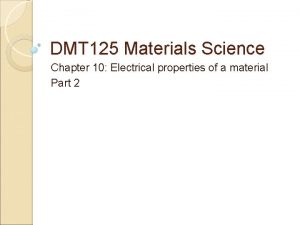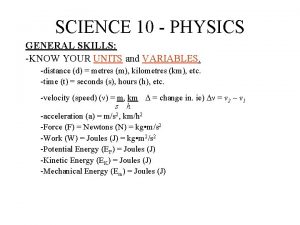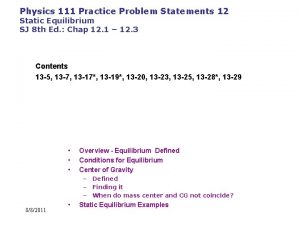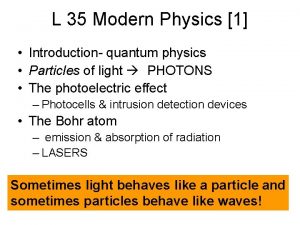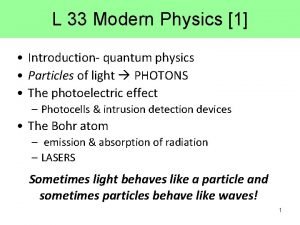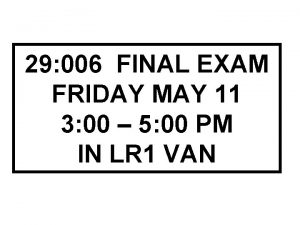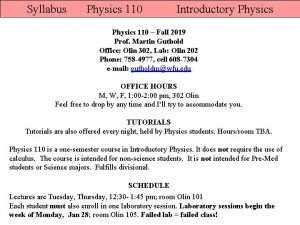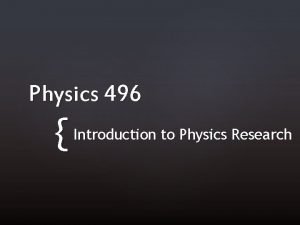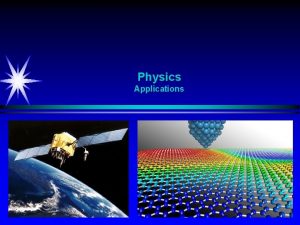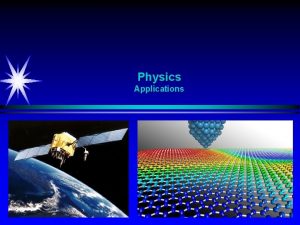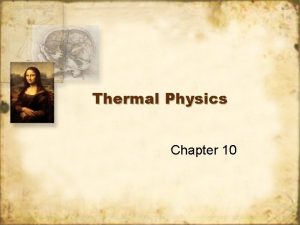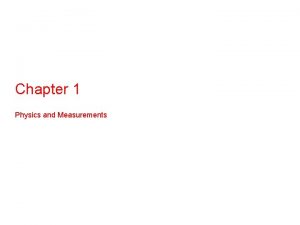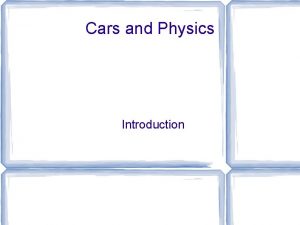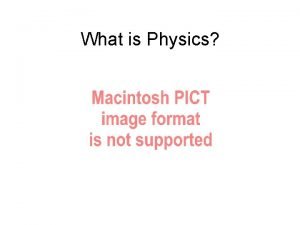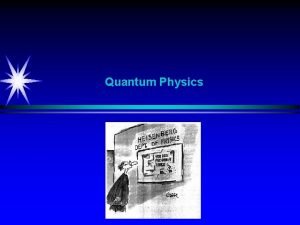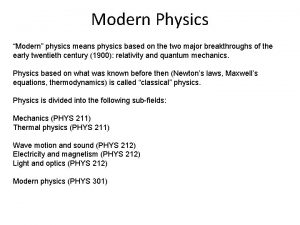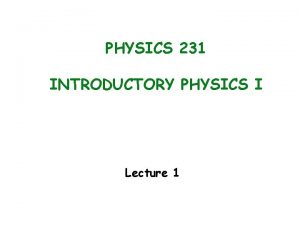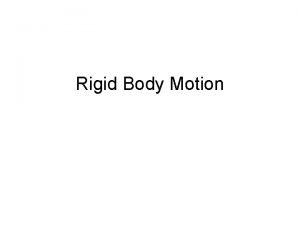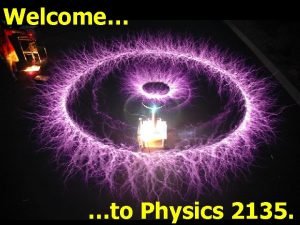Chapter 1 Introduction to Physics what is Science



















- Slides: 19

Chapter 1 Introduction to Physics

what is Science? How many branches of Science are? � To consider, to observe, to calculate the result and to done experiment on any substance in the universe is called science. � The following natural phenomena's give us the knowledge of science. � 1. Color in rainbow � 2. Dropping of an apple from tree � 3. Rusting of iron � 4. Growing of plants � 5. Motion of bodies � 6. Formation of the solar system.

BRANCHES OF SCIENCE: � Basically, science consists of two main branches. � 1. Biological Science � 2. Physical Science

Define Physics. Write down the name of its branches. � The branch of physical science in which we discuss interaction between Matter and Energy is called Physics. It is an experimental science, which mostly depends upon "Experimental observation" as well as quantitative measurement.

BRANCHES OF PHYSICS: MECHANICS: In this branch, we study about the forces which are acting on matter as well as the motion and rest of body. � ELECTRICITY: In this branch, we study about the motion and rest of electric charge. � ELECTROMAGNETISM: We study and observe the laws of electrostatic and magnetism, in Electromagnetism. � SOLID STATE PHYSICS: Study about crystalline solid in which atoms are arranged in three dimensions is called Solid State Physics. � ATOMIC PHYSICS: Atomic Physics refers to study about structure, properties and behavior of electron. � NUCLEAR PHYSICS: In this branch we study about structure and properties of Nucleus as well as the reaction between the Nuclei of atoms. �

The name of Modern branches of Physics � The modern branches of Physics are as follows: � Electronics � Solid State Physics � Bio-Physics � Geo-Physics � Astrophysics � Condense Matter Physics �

HISTORY OF PHYSICS � The history of Physics is as old as the history of man, even the cave man was aware of the production of fire by rubbing two stones together. The Chinese for the time manufacture paper. Egyptian used to measure the flood level in the river Nile. The people of Indus Valley were the pioneers of decimal system. The history of physics is about 5000 years old. History of Physics consists of three periods.

INITIAL PERIOD � This period is called Greek Period which remained 9 th century; the Greeks are accepted as pioneers in the development of Physics as a systematic knowledge. The name of famous scientists of this period is: � Pythagoras � Archimedes � Euclid � Ptolemy

GOLDEN PERIOD � This period from 9 th century to 13 th century. This period is called Muslim period in which they rule as a scientist in whole world. Famous scientists were: � Jabber Bin Hayyan � Muhammad Bin Moosa Khwarizmi � Al-Razi � Yaqoob Al-Kundi � Al-Beruni � Umer Khayyam � Ibn-Al-Haitham

MODERN PERIOD � This period is started from 13 th century and still continued. This period was initiated after the declination of Muslims. The other name of this era is "European period". The famous scientist was: � Albert Einstein � Michal Faraday � Sir Isaac Newton � Graham Bell � Madam Marie Quire � Dr. Abdul Salam � Rutherford

IMPORTANCE OF PHYSICS � Physics is the essential of daily life and technology as: Radio, Radar, artificial satellite, Hydrostatic power stations, Nuclear Reactor, Diesel Engine, firm reactor and Computer etc. , they belong to daily life as well as technology. The electric power used for domestic purposes is only due to change of magnetic flux. Laser used for treatment in medical field and Defense. Electroplating, Astronomy and Defense are working only due to Physics. Nuclear Physics is used to produce electric power on a large scale. � Automobile technology works on the base of thermodynamics Physics. Radar technology works on the principle of reflection and propagation. In short, this period is totally at rest without Physics. �

Contributions of Ibn-ul-Haitham � Abu Ali Hassan Ibn-Haitham (985 -1030 A. D) � He wrote the book named "Kitb-ul-Maazir", about the branch of Physics called Optics. � He gave the laws of reflection and refraction. � He explained the luminous, non-luminous transparent and transparent objectives. � He described the different parts of eyes. � According to Ibn-ul-Haitham, when light passes through a medium then it takes minimum time to take its path. This is known as Fermat Principle. � The nature of light is the form of energy according to him. � He explained the refraction of light. � He explained the image formed by concave mirro

Contribution of Al-Beruni Abu Rehan Muhammad bin Ahmed Al-Beruni was born in a small town Berun in present Afghnistan in 973 A. D. � He was the famous scientist of Golden age. � He was a scholar, astronomer, physician, and mathematician. � He wrote more than one hundred and fifty books on Physics, Mathematics and Geography, History, Culture and Civilization, Archaeology and Biology etc. � He explained every subject from a new angle and refuted many theories about the of things, For example, in his time it was supposed and was taken as a flat that earth was a flat body. But not only rejected this notion but practically proved that earth is round and not flat. � He also measured the circumference of earth. �

Contributions His famous book "kitab Ul Qanoon Ul Masoodi" is considered as an encyclopedia of Astronomy. � He discussed the measurement of earth, the shape of the earth, the movement of sun and moon, the phases of the moon and the movement of then known planets in his famous book Qanoon Al Masoodi. � He gave the method of determining the longitude and altitude of a place. � He also determined the densities of the metals. � He also disclosed that Indus Valley was once the basin of an Ocean and it was gradually filled up mud. Now it has been confimed by modren geologists. � In the sight of above contribution, Al-Beruni is called Versatile Scientist. �

Contributions of Yaqoob Kundi � Yaqoob Kundi was born in Basra. His life span was (800 -873 A. D. ) � He was a famous Arab philosopher. � He has 244 books at his credit. � He gave the idea about specific gravity and on Tides. � His most important work was in sound optics. � He explained the appearance of blue color in the sky. � He explained the idea that gold cannot be made from other metals. � He also explained music from scientific point of view by expressing the different notes of music in terms of frequencies. � He also discussed the nature of sound.

The part of Muhammad-Bin. Moosa Al-Khwarizmi in science � � � � � Muhammad-Bin-Moosa Al-Khwarizmi He was one of greatest scientists of his time. He was an important member of the great institution of hearing the Bait-ul-Hikmat established by the great Abbasid Caliph Mammon Ur Rashid. He was the founder of Algebra. He wrote first book in the world on subject of Algebra name "Aljab-al-Muqabla". He also gave analytical solution of linear and quadratic equations. He introduced the method of counting based on numerals and decimal system which is used all over the world until now. He was also involved in the measurement of angles. He simplified the method of addition, subtraction, multiplication and divisions.

Contribution of Nasi-ud-din Bin Hassan Tusi �A great mathematician, astronomer, geographer and astrologer of his time. � His chief contribution was his success in persuading Halaku Khan to issue necessary instructions for the creation of grand observatory and a library. � He prepared very precise and accurate tables about the planetary motion.

Contribution of Dr. Abdul Salaam He was born in Jhang, a small city in Pakistan in 1926. � A famous Pakistani scientist passed every examination with flying colors. � He got higher education from UK. � He was awarded Noble prize in Physics for his work on Grand Unification theory (GUT). � He established International centre for theoretical Physics at Trieste in Italy. �

Contributions of Dr. Abdul Qadeer Khan � He invent the atomic bomb and made the country atomic power.
 My favourite subject is science because
My favourite subject is science because K5 think central
K5 think central Physics chapter 1 introduction and mathematical concepts
Physics chapter 1 introduction and mathematical concepts Introduction to management science chapter 9 solutions
Introduction to management science chapter 9 solutions Introduction to management science chapter 1 solutions
Introduction to management science chapter 1 solutions Introduction to materials science for engineers chapter 10
Introduction to materials science for engineers chapter 10 Chapter 1 introduction to science
Chapter 1 introduction to science Chapter 1 introduction to earth science
Chapter 1 introduction to earth science Introduction to materials science for engineers chapter 10
Introduction to materials science for engineers chapter 10 Forensic science chapter 1
Forensic science chapter 1 Modern physics vs classical physics
Modern physics vs classical physics University physics with modern physics fifteenth edition
University physics with modern physics fifteenth edition Physics ia exemplars
Physics ia exemplars Science 10 physics review
Science 10 physics review Chemistry: the central science chapter 14 answers
Chemistry: the central science chapter 14 answers Introduction to static equilibrium mastering physics
Introduction to static equilibrium mastering physics Modern physics
Modern physics Modern physics introduction
Modern physics introduction Modern physics introduction
Modern physics introduction Introduction to physics 110
Introduction to physics 110



